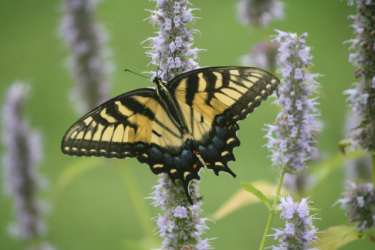 Yellow Swallowtail Butterfly on Agastache blossoms
Yellow Swallowtail Butterfly on Agastache blossoms
Agastache foeniculum, commonly known as anise hyssop, is an upright, clump-forming perennial of the mint family that is native to parts of the upper Midwest and Great Plains (Wisconsin to Ontario west to British Columbia and south to Colorado). It is typically found in prairies, dry upland forested areas, plains and fields. It grows to 2-4' tall. It is noted for its mid- to late summer bloom of lavender to purple flowers in terminal spikes and its anise-scented foliage. Square stems are clad with ovate to broad-lanceolate dull green leaves (to 4" long) with toothed margins. Flowers appear in many-flowered verticillasters (false whorls) which are densely packed into showy, cylindrical, terminal flower spikes (3-6" long). Gaps sometimes appear along the flower spike. Individual, tiny, tubular, two-lipped flowers (each to 1/3" long) have no fragrance. Flowers are attractive to bees (good nectar plant), hummingbirds and butterflies. Aromatic leaves can be used to make herbal teas or jellies. Seeds can be added to cookies or muffins. Dried leaves can be added to potpourris. Agastache comes from the Greek words for “much” (agan) and “grain stalk” (stachys) in reference to the flower spikes. Foeniculum comes from a Latin word meaning hay. (Missouri Botanical Garden)
